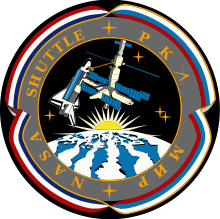STS-71
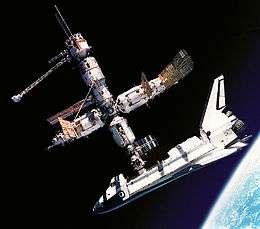 | |||||
| Mission type | Shuttle-Mir | ||||
|---|---|---|---|---|---|
| Operator | NASA | ||||
| COSPAR ID | 1995-030A | ||||
| SATCAT № | 23600 | ||||
| Mission duration | 9 days, 19 hours, 23 minutes, 9 seconds | ||||
| Distance travelled | 6,600,000 kilometres (4,100,000 mi) | ||||
| Orbits completed | 153 | ||||
| Spacecraft properties | |||||
| Spacecraft | Space Shuttle Atlantis | ||||
| Payload mass | 12,191 kilograms (26,877 lb) | ||||
| Crew | |||||
| Crew size |
7 up 8 down | ||||
| Members |
Robert L. Gibson Charles J. Precourt Ellen S. Baker Gregory J. Harbaugh Bonnie J. Dunbar | ||||
| Launching |
Anatoly Solovyev Nikolai Budarin | ||||
| Landing |
Gennady Strekalov Vladimir Dezhurov Norman E. Thagard | ||||
| Start of mission | |||||
| Launch date | 27 June 1995, 19:32:19 UTC | ||||
| Launch site | Kennedy LC-39A | ||||
| End of mission | |||||
| Landing date | 7 July 1995, 14:55:28 UTC | ||||
| Landing site | Kennedy SLF Runway 15 | ||||
| Orbital parameters | |||||
| Reference system | Geocentric | ||||
| Regime | Low Earth | ||||
| Perigee | 342 kilometres (213 mi) | ||||
| Apogee | 342 kilometres (213 mi) | ||||
| Inclination | 51.6 degrees | ||||
| Period | 88.9 min | ||||
| Docking with Mir | |||||
| Docking port | Kristall forward | ||||
| Docking date | 29 June 1995, 13:00:16 UTC | ||||
| Undocking date | 4 July 1995, 11:09:42 UTC | ||||
| Time docked | 4 days, 22 hours, 9 minutes 26 seconds | ||||
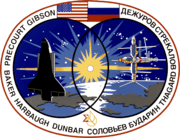 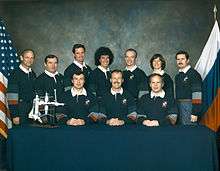 Left to right - Seated: Dezhurov, Gibson, Solovyev; Standing: Thagard, Strekalov, Harbaugh, Baker, Precourt, Dunbar, Budarin
| |||||
STS-71 was the third mission of the US/Russian Shuttle-Mir Program and the first Space Shuttle docking to Russian space station Mir. It started on 27 June 1995 with the launch of Space Shuttle Atlantis from launch pad 39A at the Kennedy Space Center in Florida. The shuttle delivered a relief crew of two cosmonauts Anatoly Solovyev and Nikolai Budarin to the station and recovered Increment astronaut Norman Thagard. Atlantis returned to Earth on 7 July with a crew of eight. It was the first of seven straight missions to Mir flown by Atlantis.
For the five days the shuttle was docked to Mir they were the largest spacecraft in orbit at the time. STS-71 marked the first docking of a space shuttle to a space station, the first time a shuttle crew switched members with the crew of a station, and the 100th manned space launch by the United States. The mission carried Spacelab and included a logistical resupply of Mir. Together the shuttle and station crews conducted various on-orbit joint US/Russian life science investigations with Spacelab along with the Shuttle Amateur Radio Experiment-II (SAREX-II) experiment.
Crew
| Position | Launching Crew Member | Landing Crew Member |
|---|---|---|
| Commander | Fifth spaceflight | |
| Pilot | Second spaceflight | |
| Mission Specialist 1 | Third spaceflight | |
| Mission Specialist 2 | Third spaceflight | |
| Mission Specialist 3 | Fourth spaceflight | |
| Mission Specialist 4 | EO-19 Fourth spaceflight |
EO-18 Fifth spaceflight |
| Mission Specialist 5 | EO-19 First spaceflight |
EO-18 First spaceflight |
| Mission Specialist 6 | None | EO-18 Fifth spaceflight |
Mission highlights
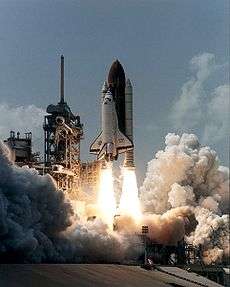
The primary objectives of this flight were to rendezvous and perform the first docking between the Space Shuttle and the Russian Space Station Mir on 29 June. In the first U.S.-Russian(Soviet) docking in twenty years, Atlantis delivered a relief crew of two cosmonauts Anatoly Solovyev and Nikolai Budarin to Mir.
Other prime objectives were on-orbit joint United States of America-Russian life sciences investigations aboard SPACELAB/Mir, logistical resupply of the Mir and recovery of US astronaut Norman E. Thagard.
Secondary objectives included filming with the IMAX camera and the Shuttle Amateur Radio Experiment-II (SAREX-II) experiment.
STS-71 was the 100th U.S. human space launch conducted from Cape Canaveral, the first U.S. Space Shuttle-Russian Space Station docking and joint on-orbit operations; largest spacecraft ever in orbit; and the first on-orbit changeout of Shuttle crew.
Docking occurred at 9 am EDT, 29 June, using R-Bar or Earth radius vector approach, with Atlantis closing in on Mir from directly below. R-bar approach allows natural forces to brake the orbiter's approach more than would occur along standard approach directly in front of the space station; also, an R-bar approach minimizes the number of orbiter jet firings needed for approach. The manual phase of the docking began with Atlantis about a half-mile (800 m) below Mir, with Gibson at the controls on aft flight deck. Stationkeeping was performed when the orbiter was about 75 metres (246 ft) from Mir, pending approval from Russian and U.S. flight directors to proceed. Gibson then maneuvered the orbiter to a point about 10 metres (33 ft) from Mir before beginning the final approach to station. Closing rate was close to the targeted 0.1 foot per second (30 mm/s), being approximately 0.107 foot per second (33 mm/s) at contact. Interface contact was nearly flawless: less than 25 millimetres (0.98 in) lateral misalignment and an angular misalignment of less than 0.5 degrees per axis. Docking occurred about 216 nautical miles (400 kilometres (250 mi)) above Lake Baikal region of the Russian Federation. The Orbiter Docking System (ODS) with Androgynous Peripheral Docking System served as the actual connection point to a similar interface on the docking port on Mir's Kristall module. ODS, located in the forward payload bay of Atlantis, performed flawlessly during the docking sequence.
When linked, Atlantis and Mir formed the largest spacecraft ever in orbit, with a total mass of about 225 metric tons (almost one-half million pounds), orbiting some 218 nautical miles (404 kilometres (251 mi)) above the Earth. After hatches on each side opened, STS-71 crew passed into Mir for a welcoming ceremony. On the same day, the Mir 18 crew officially transferred responsibility for the station to the Mir 19 crew, and the two crews switched spacecraft.
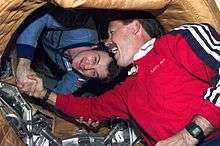
For the next five days, about 100 hours in total, joint U.S.-Russian operations were conducted, including biomedical investigations, and transfer of equipment to and from Mir. Fifteen separate biomedical and scientific investigations were conducted, using the Spacelab module installed in the aft portion of Atlantis's payload bay, and covering seven different disciplines: cardiovascular and pulmonary functions; human metabolism; neuroscience; hygiene, sanitation and radiation; behavioral performance and biology; fundamental biology; and microgravity research. The Mir 18 crew served as test subjects for investigations. Three Mir 18 crew members also carried out an intensive programme of exercise and other measures to prepare for re-entry into gravity environment after more than three months in space.
Numerous medical samples as well as disks and cassettes were transferred to Atlantis from Mir, including more than 100 urine and saliva samples, about 30 blood samples, 20 surface samples, 12 air samples, several water samples and numerous breath samples taken from Mir 18 crew members. Also moved was a broken Salyut-5 computer. Transferred to Mir were more than 450 kilograms (990 lb) of water generated by the orbiter for waste system flushing and electrolysis; specially designed spacewalking tools for use by the Mir 19 crew during a spacewalk to repair a jammed solar array on the Spektr module; and transfer of oxygen and nitrogen from Shuttle's environmental control system to raise air pressure on the station, to improve Mir's consumables margin.
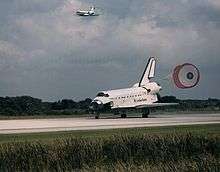
The spacecraft undocked on 4 July, following a farewell ceremony, with the Mir hatch closing at 3:32 pm EDT. 3 July and hatch on Orbiter Docking System shut 16 minutes later. Gibson compared separation sequence to a "cosmic" ballet: Prior to the Mir-Atlantis undocking, the Mir 19 crew temporarily abandoned station, flying away from it in their Soyuz spacecraft so they could record images of Atlantis and Mir separating. Soyuz unlatched at 6:55 am EDT, and Gibson undocked Atlantis from Mir at 7:10 am EDT.
The returning crew of eight equaled the largest crew (STS-61-A, October 1985) in Shuttle history. To ease their re-entry into gravity environment after more than 100 days in space, Mir 18 crew members Thagard, Dezhurov and Strekalov lay supine in custom-made recumbent seats installed prior to landing in the orbiter middeck.
Inflight problems included a glitch with General Purpose Computer 4 (GPC 4), which was declared failed when it did not synchronize with GPC 1; subsequent troubleshooting indicated it was an isolated event, and GPC 4 operated satisfactorily for the remainder of mission.
During the SAREX portion of the flight, the crew contacted several schools. One was Redlands High School in Redlands, CA. Charlie Precourt was able to contact students and technicians that built the communications package for a window of about 10 minutes.
See also
- List of human spaceflights
- List of human spaceflights to Mir
- List of Space Shuttle missions
- Outline of space science
- United States Astronaut Hall of Fame#Exhibits
References
![]() This article incorporates public domain material from websites or documents of the National Aeronautics and Space Administration.
This article incorporates public domain material from websites or documents of the National Aeronautics and Space Administration.
